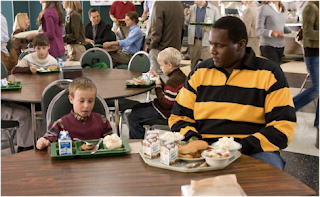Act one: This act introduces the protagonist, Michael Oher, “Mike,” who arrives at Wingate Christian School. Here, he befriends Sean Jr. "SJ" and develops the characters in the film. One night, Leigh Anne Tuohy, SJ’s mother, notices Michael walking on the road, shivering in the cold and offers him a place to sleep. This is the peak of this act. But the act continues to show the progression of Mike’s integration into the Tuohy family.
Plot point 1: 43
Act Two: The transition to the topic of football presents the complication in the film. After Mike joins the school football team, he is offered various scholarships and must decide on a school. Leigh Ann clearly prefers the University of Mississippi where both her and her husband attended. However, because of this, the Touhys must undergo an NCAA investigation where Mike is told that the Tuohys are Ole Miss boosters and is questioned about why he chose the school. The act peaks when Michael confronts Leigh Anne, asking if she only took him in so he would play football for her alma mater. Mike leaves, ending the act.
Plot point two: 55
Act Three: The resolution is presented when Leigh Anne finally finds Mike, and tells him she will support any decision he makes. Michael returns and satisfies the investigator by explaining that he chose Ole Miss because his whole family has gone there. The peak of this act is Mike’s decision to attend the University of Mississippi.
Climax: 22




_11.jpg)


